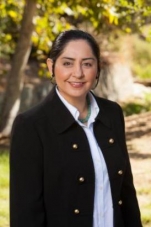

By Leon Thompson, Tribal Beat reporter, East County Magazine
December 17, 2015 (San Diego’s East County) -- Erica Pinto (photo, left) and the Jamul Indian Village hosted the premier showing of A Thousand Voices, a documentary film from Silver Bullet Productions an educational filmmaking program for rural and tribal communities.
This is the story of Native American women in New Mexico from the Pueblo, the Dine’ and the Apache nations. A common thread is that all are accomplished women leaders held in esteem as keepers of the culture. Matriarchal in many ways, men and women are equal in the creation stories of indigenous people from the beginning of time.
View the Trailer here: https://www.youtube.com/watch?v=mXfEpcGTe9A (Scroll down or hit "read more" for our review)
Through the invasions from Spain, Mexico, and the United States as well as forced assimilation imposed by boarding schools, the power of women remains - and the story continues.
“At the center of it all is Woman, and nothing is sacred without her blessing and her thinking.” -- Paula Gunn Allen, The Sacred Hoop.
Native American women hold a completely different place in society than European white people could understand. The male-dominant invaders recognized only men as leaders. Women were essentially demoted by the invading powers with a sword in one hand and the Bible in the other--a major violation of the preciousness of women in our society.
According to Genesis, woman came from Adam’s rib. In Native American origin stories, man and woman were created together as a single unit, complementing and completing each other. Imagine a society where women are equal to men and always have been.
“For centuries Native women were pushed down – but they would never be silenced. Now they are reclaiming their power and becoming the leaders they were meant to be.”-- A Thousand Voices
“All my relatives all my family they are there with me in spirit - a thousand voices.” --Luci Topahanso, Dine’ woman.
 Each woman tells a story deeply rooted in her culture… and the ‘thousand voices’ that precede her.
Each woman tells a story deeply rooted in her culture… and the ‘thousand voices’ that precede her.
As the film ended, you could have heard a pin drop in the Kroc Center Auditorium. Later, the words I heard most to describe the film were powerful, profound and provocative.
Chairwoman Erica Pinto wasn’t the only one beaming with pride for the women in the film. Everyone was, from audience members to producer Pamela Pierce. There were even a few tears of joy.
I couldn’t help thinking about Jane Dumas, Florence Shipek, Rose Margaret Orrantia, and sitting in the front row, Carlene Chamberlain who has done so much to help bring healthcare to our rural tribes. Carlene’s Daughter, rising rez star Erica Pinto hinted at producing a film about our own great Kumeyaay women.
These are among a great cloud of powerful and influential women:
Wilma Mankiller, the Cherokee Chief whose accomplishments are legendary and who many hoped would replace Andrew Jackson on the twenty dollar bill,
Winona LaDuke , the Anishinaabe environmentalist from Minnesota who started the White Earth Land Recovery Project and Honor the Earth - and
Freda Huson, who barricaded all the roads to her reservation, refusing to let Enbridge build pipelines across pristine lakes, forests and rivers on the Unist’ot’en reservation in Western Canada.
Most Native American societies are matriarchal in nature with special tasks for each Clan. Governance was traditionally centered on social responsibility, taking care of the people’s needs as only a mother can. How can you argue with over 10,000 thousand years of success before the white European patriarchs landed on our shores and invaded our lands?
As the Pueblo leader said, “we do not go to war unless the women say we can go to war, because those are our babies.”
This powerful film makes one wonder how different our world might be if we could give the country back to the Indians and let the women rule.
Please help us cover more Tribal Beat stories by donating or joining our Editor's Club (for those making sustaining monthly pledges) at http://www.eastcountymagazine.org/donate. If you wish, you can list "Tribal Beat" in your donation designation. East County Magazine's mission is to reflect all voices in our communitiy, especially those often not heard in other media. We are published by the nonprofit 501(c)3 Heartland Coalition.
As nonprofit media, we rely on the generous support from our readers to sustain and grow our news in the public interest. Our site has won 88 journalism awards for our multi-cultural reporting, environmental coverage, and community news in the public interest, also drawing 150,000 visits each month to our site. Our costs have risen and so have requests from readers for us to cover more and more stories in our region. We are also seeking sponsors/underwriters for our Tribal Beat and other special sections to help sustain and grow our coverage of stories and issues that matter most to you. We reflect your interests, not special interests--and we are deeply appreciative of our donors and supporters in our community.










Recent comments